Demographics of Sabah
The 2015 Malaysian Census reported the population of Sabah at 3,543,500, being the third most populous state in Malaysia and have the highest non-citizens population at 870,400.[1] However, as Malaysia is one of the least densely populated countries in Asia, Sabah is particularly sparsely populated with most of the population concentrated in the coastal areas since towns and urban centres have massively expanded. The statistics in 1970 reported the population of Sabah with only 653,600,[2] with both the state and its neighbour of Sarawak has about the same number of foreign nationals.[3] By 1980, the state population saw a sudden increase to over 1,011,000 following the influx of refugees who fleeing a conflict in the neighbouring southern Philippines.[2][4] At the same time, Sabah economic booms in the primary sector also attracted large legal workers from both Indonesia and the Philippines.[5][6] This increase to over 1,863,600 in 1991,[2] 2,603,485 in 2000,[7] and by 2010 turned into 3,117,405.[8][9] Sabah has 900,000 registered migrant workers working in agriculture, plantation, construction, services and domestic workers.[10] While the total number of illegal immigrants (including refugees)[note 1] are predicted to be as more than one million due to the past controversial regularisation for political reasons,[12] with most of them are believed to have been categorised as "other bumiputera" category group in the country statistics.[1][13] Sabah also seen a great increase in the number of expatriates, with most of them comes from China, Taiwan, South Korea, Japan, Australia and Europe.[14]
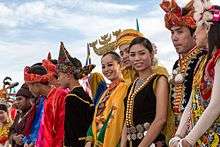
| Year | Pop. | ±% |
|---|---|---|
| 1970 | 653,600 | — |
| 1980 | 1,011,000 | +54.7% |
| 1991 | 1,863,600 | +84.3% |
| 2000 | 2,603,485 | +39.7% |
| 2010 | 3,117,405 | +19.7% |
| Note: Include Labuan in 1970. Source: Malaysian Population Statistics | ||
People from Sabah are generally called Sabahans and identify themselves as such.[15] There is an estimate of 42 ethnic groups with over 200 sub-ethnic groups with their own language, culture and beliefs which predicted to be increase more in the future due to high interracial marriage and recent migration.[16] The coastal and low land areas are inhabited mostly by Bajau, Bruneian Malay, Bugis, Cocos Malays, Illanun, Kedayan and Suluk who are traditionally working as fishermen and farmers.[17] While high land areas and interior are inhabited mostly by the Kadazan-Dusun peoples, Murut, Lun Bawang/Lun Dayeh and their sub-groups as farmers and hunters.[18] Bumiputera (son of the soil) refers to the Malays and other indigenous groups in Peninsular Malaysia, Sarawak and Sabah. This group of people generally enjoy special privileges in education, jobs, finance and political positions.[19] Orang Asal refers to all the indigenous groups in Malaysia excluding Malays.[20]
The three largest indigenous group in Sabah are the Kadazan-Dusun, Bajau and Murut; followed by the Bruneian Malays, Suluk and other indigenous,[21] while the Chinese makes up the main non-indigenous population.[22]
Ethnic groups
Kadazan-Dusun
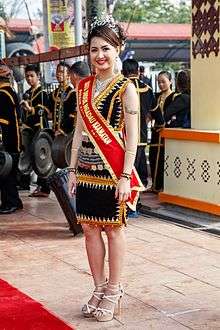
Kadazan-Dusun is the largest indigenous group in Sabah, comprising the blending of two groups with 40 sub-groups.[23][21] Every sub-groups has different language and tradition although they can understand each other. The term Kadazan-Dusun is commonly used to refer to the Kadazan and Dusun peoples.[24] Although the term are mainly used to unifying the two groups, it is also include the other sub-groups including the Murut, Orang Sungai, Rungus, Tidong and Lun Bawang/Lun Dayeh peoples.[25] Nowadays, the Kadazans are mainly reside in urban areas, while Dusun often reside in the hills and upland valleys.[23] The Kadazans are mostly settled the area around Penampang, Papar, Ranau, Tambunan and Keningau while the Dusuns are mostly concentrated in the area of Tuaran, Ranau and also Tambunan.[26] They are once known for their headhunting practice as well for their occupation as farmers, hunters and river fishers.[23][27]
The Kadazan once lived in longhouses,[28] while the Dusun lived in a single traditional house though some of them were also living in a longhouse. As both of them are traditionally rice farmers, they celebrate an annual harvest festival known as the Kaamatan.[29][30] The Kadazan-Dusun community has a belief that their ancestor come from the Nunuk Ragang (a red banyan tree). Located not far from the tree there is two rivers of Liwagu and Gelibang, which become the route where their community spread to all over interior places in Sabah.[31]
Bajau
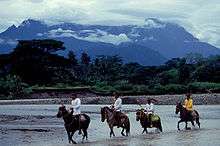
The second largest indigenous group is the Bajau. The Bajaus in Sabah is divided into two main groups, the West Coast and East Coast.[26] The West Coast Bajau generally lived in land and known for their traditional horse culture.[32] They mostly settled the area from Kota Belud, Kota Kinabalu, Tuaran and Papar. While the East Coast Bajau are mostly spending their lives in the sea with their annual "regatta lepa" festival and settled around the area of Semporna, Lahad Datu and Kunak.[32][33][34]
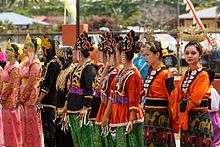
Once known as seafarers, the West Coast Bajau have start to learning farming and cattle rearing since their migration from the Philippine archipelago a long time ago.[26][21] Their skills in horsemanship are well known locally and they will perform the culture on their festive occasions with the riders will be dressed in colourful traditional costumes.[32] The East Coast Bajau on the other side are still living in traditional ways, with fishing became the main source of income.[32] Most of them lived in stilt water villages and some spending most of their lives in their boat. The East Coast Bajau are also known as good divers of which they can spend more than five minutes in the waters without using oxygen tank.[35]
Murut
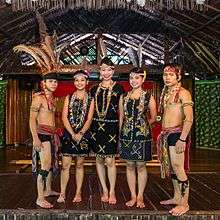
The Muruts became the third largest indigenous group of Sabah, settling the areas around Keningau, Tenom, Nabawan, Pensiangan and along the river areas of Sapulut, Padas and Kinabatangan.[26] Like the Kadazan-Dusun, they are also once known for their headhunting practice, and now as a farmer and hunters.[21] The Muruts are once living in a longhouse, but today they have adapt a modern housing although the Muruts in the north of Sabah still living in a longhouse.[36] The Muruts have a great knowledge of botanical healers with each of their community has their own herbalist that can cure such illness ranging from diarrhoea, diabetes and high blood pressure.[26] Since the abolishment of headhunting by the British, many of them have served as a police and soldiers for the British. This was maintained until this date when many of the Muruts served in the Malaysian Armed Forces. The Muruts also celebrating a harvest festival like the Kadazan-Dusun, although their festival is called Kalimaran.[37]
Brunei/Kadayan
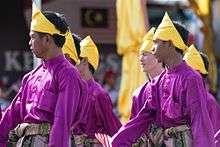
The traditional Malays in the state are the Bruneian Malays who mostly inhabit the area in south-west coast. They mostly settled in Beaufort, Sipitang, Kuala Penyu and Papar. Their migration to northern Borneo is noticeable during the rule of the Sultanate of Brunei.[38] The Cocos Malays and Kedayan are also include on this group together with the recent Malays who migrated from the Peninsular Malaysia.[21] As Malays are defined by the Malaysian Constitution as those who are Muslims, speak and conforms to Malays customs.[21] But although the Bruneian are Malays, their culture and language are slightly different from the majority Malays in the Peninsular.[39]
Suluk
The Suluks settled around the east coast of Sabah, mainly in Sandakan, Semporna and Lahad Datu. They start to settled in the areas since their migration from the Sulu Archipelago during the rule of the Sultanate of Sulu,[40][41] together with the Bajaus and Illanuns.[42][43] Many of them at the time are believed to have fleeing the slave trade in the Sulu Archipelago,[44] Spanish oppression,[45] as well some are actually descendants of Sulu princess (Dayang-Dayang) who fleeing from the Sultan of Sulu who tried to make the princess as his wife.[46] The indigenous Suluks are different from the recently arrived Tausūg immigrants from the Philippines as they have embracing the multiculturalism in northern Borneo and most of their community leader have prefer to researchers to not putting them in the same position with the Filipino-Tausūgs.[47][48]
Chinese
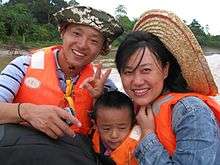
Forming the largest non-indigenous group is the Chinese, many of whom arrived before the arrival of the British to northern Borneo as shown in both Brunei and Sulu sultanates records,[49] as well from British records itself.[50] The earliest documentation of Chinese settlement in Sabah dates back in the 7th century on the Kinabatangan River banks.[26] However, the links between northern Borneo and China could be much longer since during the Han dynasty.[51] The migration of Chinese to northern Borneo saw a significant increase following the establishment of North Borneo Chartered Company in 1881. At the time, the British considered the native populations was too small to boost North Borneo economy.[51] Until this day, the Chinese are very important to the state economy as their activity in engaging in business related activities.[52] The Chinese in Sabah can be divided into three main groups of Hakka, Cantonese and Hokkien people. The Hakka formed the majority of Chinese in Sabah,[53] followed by Cantonese and Hokkien.[23] There is also a community of northern Chinese in the state, with most of them identified themselves as Tianjin ren (people from Tianjin).[54] All the Chinese community are united under the Sabah United Chinese Chambers of Commerce (SUCC), an organisation that promotes national unity and continuous contribution towards the state economy.[55]
Religion
Before the arrival of Islam and Christianity, the indigenous of North Borneo are mainly practising Animism and Paganism.[57][58] Islam was then arrived in the 10th century on the west coast of Borneo following the conversion of the first ruler of Brunei into Islam.[59] In addition with the spread of Islamic teachings from Sulu and Sulawesi into the coastal areas of eastern Borneo.[59] The first Christian missionary in northern Borneo is by a Spanish mariner and priest known as Rev. Msgr. Carlos Cuarteron, although at the time the British had establish their presence in the island of Labuan.[60] While Buddhism, Taoism and other Chinese folk religion as well Indian religion of Hinduism and Sikhism arrived as a result of the migration of Chinese and Indian into northern Borneo.[61][62]
Since the amendments of 1973 Sabah Constitution by the latter Chief Minister of Mustapha Harun, Islam is declared as the state religion.[63] However, the amendments are considered to be controversial as it is against the 20-point agreement that was agreed upon the formation of Malaysia that already stated there should be no any state religion for North Borneo.[64][65] It is believed that this was happened when the demand of the indigenous people was not protected when the constitution was to be amended.[64][65] In 1960, the population percentage of Muslims was only (37.9%) about the same par with Animist (33.3%), while Christians at (16.6%) and other religion (12.2%).[64] But following Mustapha Harun taking up the power, the Muslim population suddenly increase rapidly.[66] Until 2010, the percentage of Muslims had increase to (65.4%), while Christians grew (26.6%) and Buddhist at (6.1%).[67] While the population percentage of both Animist and Pagans were significantly decrease prior to the controversial political motivated demographic change.[68] As a result, the influence of both Christianity and Islamic missions have greatly changing the religious faith of the people of Sabah who are majority Animists before.[69]
- Religious sites in Sabah
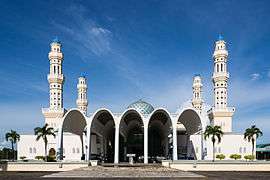
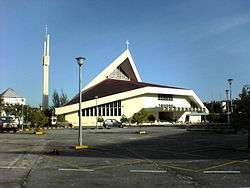

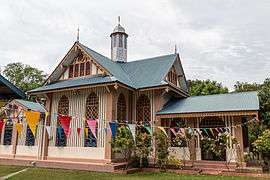 Gurudwara Sahib
Gurudwara Sahib
Mass conversion and autonomy in freedom of religion issues
Since the colonial period, various Christian groups from the West had actively engaged to Christianise the native Animist indigenous peoples of North Borneo. However, when Sabah was being administered by Mustapha Harun, the Christian groups were later involved in a dispute with Mustapha over the alleged discrimination, biased and unfair treatment to them.[70] Under Mustapha's political party of USNO, large-scale Islamisation was carried out by the United Sabah Islamic Association (USIA).[71] The organisation at the time expelled a number of Christian missionary workers, converted elite politicians and carried out mass conversion on Animist villagers as well as some older Chinese generations in exchange for their citizenship.[72] This was followed by the influx of Filipino refugees from Mindanao as well Indonesian immigrants from Sulawesi who are majority Muslim that were harboured to increase the Muslim populations.[67][73][74] After the fall of USNO when BERJAYA's adopted the "multi-racial principles" which won the vote from non-Muslims, the party however began to adopted Islamic vision with the establishment of Majlis Ugama Islam Sabah (MUIS).[72] The conversion of indigenous villagers became rampant at the time. This also led to the fall of BERJAYA when the support from non-Muslim began to decrease when they start to interfere on the indigenous faith and rituals.[72]
Moreover, since the amendments of the controversial 1973 constitution, Sabah has been facing more mass religious conversion cases. There are highly controversial issues such as the indigenous natives who have been either Christian or no religion were marked as a Muslim when they received their identity cards after applying for it.[75] This was as a result of the authorities in the federal government located in the Peninsular got confused with the using of "bin" and "binti" in the birth certificates of the indigenous Sabahans.[75][76] Beside that, there is a frequent report that villagers were tricked to follow other religion by certain non-governmental organisations from the Peninsular Malaysia,[77] as well the conversion of students in schools by teachers from the Peninsular without their parents' knowledge.[78]
While any non-Muslims in the state who want to convert to Islam can be easily accepted by the state law, any Muslims who wish to leave their religion will be detained in the state Islamic Rehabilitation Centre until they repent or jailed for up to 36 months (3 years).[79][80] A bid for the establishment of Sabah first Christian radio also went unheeded by the federal government communication ministry until it was brought up to court.[81][82] In addition, the religious zealotry and intolerance from certain Muslims hardcore groups in the Peninsular have start to affecting the state cultural and religious diversity.[83] The federal government however have denied any links with all the controversial conversions that was done by certain quarters and said that it is not the policy of the government to forced someone to change their religion.[84] Prior to this, there has been a frequent calls to the government to restore the freedom of religion in the state and to respecting each other's religion to prevent any further religious tensions which affecting the harmonious that have long been practised in the state.[85]
Languages
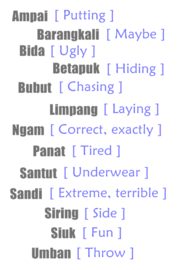
The indigenous languages of Sabah can be divided into four language families, i.e. Dusunic, Murutic, Paitanic and Sama–Bajau. Studies suggest that the only truly Bornean languages spoken in Sabah are those belonging to the Dusunic, Murutic and Paitanic language families [86] while the Sama–Bajau languages originate from the southern Philippines.[87] The Dusunic is the largest of the four families. It comprises the Kadazan Dusun language, which has dialects spread throughout the districts of Papar, Penampang, Kota Kinabalu, Tuaran, Ranau, Tambunan and Keningau.[87] It is followed by the Murutic languages of southern Sabah, which are spoken mainly in Keningau, Tenom, Nabawan and Pensiangan. The Paitanic languages are spoken in the areas along the east coast rivers of Paitan, Kinabatangan and Segama.[87] The Sama–Bajau are concentrated along parts of the West and East Coasts.[88] Malay language is taught as the main language for conversation across different ethnicities in the state, although Sabahan creole is different from Sarawak Malay and Peninsular Malay.[89] Sabah has its own slang for Malay which originated either from indigenous words, Brunei Malay, Suluk, Cocos Malay and Indonesian language.[90]
The large Chinese minority in Sabah are mostly of the Hakka subgroup. As such, the Hakka dialect is the most commonly spoken Chinese dialect in the state. There are also significant minorities speaking other dialects, particular the Cantonese and Hokkien dialects. Additionally, as Chinese schools in Malaysia use Mandarin as the language of instruction, many Chinese Sabahans are also proficient in Mandarin, albeit a "Malaysianised" form of it.[91] While a Spanish-based creole, Zamboangueño, a dialect of Chavacano, has spread into one village of Sabah in Semporna prior to the migration of people from the southern Philippines.[92]
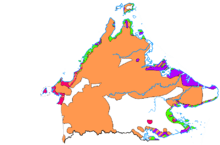
(click image to enlarge)
In 1971, the state government of Sabah under Mustapha Harun submitted an enactment recognising Malaysian language as the state's official language.[93] Following the amendments of 1973 Constitution, the use of English language has been restricted to only for official purposes with the extension of the 1967 Malaysian National Language Act.[94] As a result of the domination of Malaysian language into the state, the proficiency over English language among younger Sabahan generations have been gradually decreasing.[91] The largest indigenous language of Kadazan Dusun has also become an endangered language as the language have not been made a compulsory language in the state schools.[18][95] Due to the tight Malay culture and language policies over national schools, many Sabahan bumiputera parents have preferred to send their children to Chinese schools of which based on a survey in 2010 revealed there is around 12,138 Sabahan bumiputera students enrolled in Chinese national type primary schools and preschools, becoming the second state after Sarawak with the highest number of bumiputera pupils enrolment in Chinese schools.[96] In addition with the perception among non-Chinese parents that Chinese schools provide a better quality education and were more disciplined along with the rise of China as a new global economic powers that forced the need to mastered Chinese languages.[97] Since 2014, the British Council have actively giving assistance to teach English in primary schools followed by Fulbright Program from the United States in 2015 to teaching English in secondary schools.[98][99] Kadazan Dusun language also started to be promoted at the same time, with the language teacher will complete their training in 2018 and start to teach in 2019.[100] Starting from 2016, the Sabah Education Department has set Tuesday as an English Day for schools to return the English proficiency in the state and all younger generations have been urged to converse more in English.[101]
Following the change of the government after the 2018 general election, the new Sabah government has stated that there is no restriction on the usage of English in the state, adding that even if the Education Ministry stated that it is unlawful for English be used in Sabah, they will not allow it to be imposed in the state with the state government will undo the improper law since the restrictions will only making damage to their younger generations especially when they need to work in private firms or organisations that require English proficiency. The new state government also stated that they will look into the matters if there is a need for a change in the state law.[102]
Immigration to Sabah
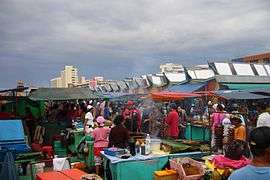
| Origin | Estimation (+) |
|---|---|
| 1,000,000[note 3] | |
| 500,000[104] | |
| 200,000[8][106] | |
| 70,000[38] | |
| 7,000[8][107] | |
| 2,000[108] | |
| 1,000 | |
| 300[109] | |
| 200[110] | |
| 100[111] | |
The movement of people between Sabah, Sarawak, Brunei, the southern Philippines and the Indonesian province of Kalimantan have existed for centuries and were not restricted at the time.[112][113] Prior to the modern laws and the lawlessness issues created by the recent immigrants, there has been emphasis to control and monitor such illegal movements. The first large-scale human migration to the modern state of Sabah occurred in the 1970s, when hundred thousands of Filipino refugees, mostly the Moros, began arriving in the state due to political uncertainty in the southern Philippines of Mindanao.[112] Unlike the case of Vietnamese refugees in the Peninsular Malaysia, where most of the Vietnamese were successfully repatriated to maintain the racial balance for the Malays there,[114] the Filipino refugees in Sabah are welcomed by certain politicians in the state mostly by USNO, BERJAYA's as well the dominant federal government political party of UMNO to increase the racial balance in favour to the Malays with the state autonomy in immigration being manipulated for political gains.[112][113] Some Vietnamese boat people refugees also reaching Sabah shores as part of the Indochina refugee crisis although most of them today have been sent to Western countries as Malaysian leader at the time Mahathir Mohamad only wants Muslim refugees who should stay in the country.[115] Since 2000, around 20,000 Muslim foreigners from the Philippines and Indonesia have married to local Sabahans, in addition to a number of foreign men from Afghanistan, Algeria and Bangladesh marrying local Sabahan women based on a figures released by the Sabah Islamic Religious Affairs Department (JHEAINS).[116]
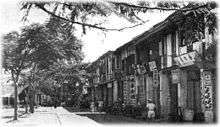
Sabah has a significant Chinese minority.[23][117] Chinese immigrants first came to Sabah from southern China in the late 19th century fleeing famine and overpopulation in their homeland. They were enticed to Sabah by the promises of British colonists, who invited them to help clear the forests and farm the land in return for various benefits.[51] While early Chinese immigrants were mostly involved in agriculture, most eventually became involved in business, operating sundry shops, coffee shops and so on. To this day, Chinese Sabahans play a pivotal role in the state's commercial scene.[52] Most Chinese Sabahans are of Hakka descent, but there are significant numbers of Chinese Sabahans from other dialect groups, especially the Cantonese and Hokkien subgroups. The largest Chinese populations in Sabah are in the three major cities of Kota Kinabalu, Sandakan and Tawau. Smaller rural communities exist, particularly in the districts of Kudat, Keningau, Tenom and Beaufort.[51]
Unlike in Peninsular Malaysia, the South Asian population in Sabah is small. It consists mainly of Indians and Pakistanis, some of whom are descended from immigrants who served in the British colonial military.[61][62] Sabah is also home to a large number of foreign immigrants from Indonesia and the Philippines. The Indonesian community is composed mostly of Buginese, Florenese, Torajans and Timorese people who have come to Sabah to work as labourers, in oil palm plantations or as domestic workers.[111][118] The Filipino community can broadly be divided into two: descendants of mostly Christian immigrants who worked as professionals during the colonial era,[119] and the mostly-Muslim immigrants from the southern Philippines who came during the USNO era.[112][113] In recent years, the number of expatriates in the state has increased. They come mostly from China, Taiwan, South Korea, Japan, Australia and various countries in Europe, particularly the United Kingdom.[14]
Demographic issues
There are many reports stating that following the influx of refugees and foreigners from the Muslim areas of Mindanao in the Philippines as well from Sulawesi in Indonesia, a "secretive taskforce" was established in the 1970s during Mustapha Harun's term as Chief Minister to register them as citizens.[120][121] The taskforce then actively engaged from 1988 to 1990 by registering not only the Muslim refugees and migrants but also to Muslims from Peninsular Malaysia to topple the state government under PBS who were majority Christian.[66][122] A source from one of the former Sabah Chief Ministers estimated the total of illegal immigrants in the state to be around 400,000–500,000 while Sabah's opposition parties together with the Filipino community leaders indicated that the numbers have surpassed one million.[12] The complicated estimate was as a result of frequent "controversial regularisation" with the illegal immigrants and refugees changing their status into "legal citizen". Most of those who have been deported also can return to the state within weeks or a few months.[12] Most of the immigration issues have been perceived by the locals as politically motivated to systematically change the demography of the state; citing a case of a local woman who had been denied citizenship until present.[123] Although the local woman had been living in the state and born to a Sabahan indigenous family, she was still being denied citizenship by the state government, while recently arrived immigrants had acquire their Malaysian identity card in just a short time though the immigrants did not have any relationship with Malaysian citizens:
I was born at home at Kg Enubai (Tenom) in 1960, so my birth was not registered then. When I turned 12, my mum brought me to the JPN Office to apply for a blue IC. It was a hassling experience as the authorities wanted proof of my local birth. We managed to find the village midwife who delivered me. But I was still given a red IC. I speak Malaysian language, Murut, Dusun, Hakka, Cantonese and Mandarin. I grew up with Murut and Dusun kids. When I talk to people in the Peninsula, they know straightaway that I am from Sabah. Even the police once said to me, 'Aunty, dari Sabahkah?' (Aunty, from Sabah?). But the Indonesian women who live in my area and can only speak Indonesian Malay have got MyKad. Isn't this strange? The Indonesian women said: 'Kami datang lima tahun, sudah dapat IC', (We have been here five years already, we have already got IC).[123]
Another indigenous woman faced difficulties in sending her child to school when the child was listed as a Muslim without the mother's consent in his recently received birth certificate from the National Registration Department (NRD) which the mother refused to accept the document as the child was born as Christian; with such cases having occurred several times and causing the department to be labelled as practicing religiously-motivated "cleansing" of the state to systematically Islamise its people.[124] This was also added to the exposure of corruption within the Malaysian authorities by an Indonesian investigative television programme in the late 2016, where thousands of Indonesian migrants managed to cross easily through the border in Tawau Division every day,[125] with many of the illegal immigrants also receiving the "Bantuan Rakyat 1Malaysia" (a type of Malaysian government aid to local low-income Malaysians in the form of money) through the fake identity cards they were using when arriving in the Malaysian territory.[126] Following the seriousness of the issues that have created some ethnic tension among Sabahans as well affecting the security and stability of the state, the federal government agreed to set up a royal commission to investigate the problems.[127] Among the proposals by Sabahan parties during the commission is to re-call all identity cards (ICs) issued in the state and issue new ICs only for eligible Sabahan citizens which will also to ensure the integrity of the Malaysian identity card system.[128][129] The federal government also been urged to speed up the process of registering all of its indigenous natives who are still stateless despite being indigenous people who supposedly deserve a special position in their own homeland.[130] Following the coverage of the issue, the Chief Minister has instructed NRD to rectify the matters immediately.[131]
Notes
- As Malaysia are not the signatories of the 1951 UN Refugee Convention, the country have maintained that any newly arrival aliens are illegal immigrants rather than refugees.[11]
- Including those who had become citizens through naturalisation, intermarriage with local natives and non-natives who are Malaysian citizen as well with the recent migration.[103]
- Including refugees.[12]
References
- "Population by States and Ethnic Group". Department of Information, Ministry of Communications and Multimedia, Malaysia. 2015. Archived from the original on 12 February 2016. Retrieved 12 February 2015.
- Jeffrey R. Vincent; Rozali Mohamed Ali (2005). Managing Natural Wealth: Environment and Development in Malaysia. Resources for the Future. pp. 6–. ISBN 978-1-933115-20-7.
- Anthony Milner; Abdul Rahman Embong; Tham Siew Yean (28 February 2014). Transforming Malaysia: Dominant and Competing Paradigms. Institute of Southeast Asian Studies. pp. 147–. ISBN 978-981-4517-91-1.
- Azizah Kassim (2009). "Filipino Refugees in Sabah: State Responses, Public Stereotypes and the Dilemma Over Their Future" (PDF). Southeast Asian Studies, Kyoto University. CiNii. Retrieved 1 June 2016.
- Helen E. S. Nesadurai (2013). "Malaysia's Conflict with the Philippines and Indonesia over Labour Migration: Economic Security, Interdependence and Conflict Trajectories". The Pacific Review. Academia.edu. doi:10.1080/09512748.2013.755360. Retrieved 1 June 2016.
- OECD (1 February 2002). International Migration in Asia Trends and Policies: Trends and Policies. OECD Publishing. pp. 129–. ISBN 978-92-64-18867-9.
- Saw Swee-Hock; K. Kesavapany (2006). Malaysia: Recent Trends and Challenges. Institute of Southeast Asian Studies. pp. 4–. ISBN 978-981-230-336-3.
- "Total population by ethnic group, administrative district and state, Malaysia" (PDF). Department of Statistics, Malaysia. 2010. Archived from the original (PDF) on 27 February 2012. Retrieved 25 February 2016.
- "'Unnatural' population growth in Sabah over the years". Daily Express. 6 December 2014. Archived from the original on 1 June 2016. Retrieved 1 June 2016.
- "Hike on foreign workers' levy irrational: FSI". New Sabah Times. 4 February 2016. Archived from the original on 2 June 2016. Retrieved 2 June 2016.
- Franklin Ng (1998). The History and Immigration of Asian Americans. Taylor & Francis. pp. 177–. ISBN 978-0-8153-2690-8.
- Kamal Sadiq (2 December 2008). Paper Citizens: How Illegal Immigrants Acquire Citizenship in Developing Countries. Oxford University Press. pp. 49–178. ISBN 978-0-19-970780-5.
- "Abnormal hike in 'Bumi Lain' category". Daily Express. 16 January 2015. Archived from the original on 2 June 2016. Retrieved 2 June 2016.
- Ian Urbina (12 February 2015). "Living Like a Local in Kota Kinabalu, Malaysia". The New York Times. Retrieved 4 July 2016.
- Philip Golingai (10 May 2015). "Sabahan first, then a Malaysian". The Star. Archived from the original on 2 June 2016. Retrieved 2 June 2016.
- Julia Chan (13 February 2015). "Sabah lists 42 ethnic groups to replace 'lain-lain' race column". The Malay Mail. Archived from the original on 1 June 2016. Retrieved 1 June 2016.
- Wendy Hutton (November 2000). Adventure Guides: East Malaysia. Tuttle Publishing. pp. 31–57. ISBN 978-962-593-180-7. Retrieved 26 May 2013.
- Anne Lasimbang; Nancy Ariaini (1 November 2012). "The Peoples of the Heart of Borneo – Keeping Borneo indigenous languages alive" (PDF). World Wide Fund for Nature. p. 14/38 (26). Archived from the original (PDF) on 2 June 2016. Retrieved 2 June 2016.
- Richard Mason; Ariffin Omar (2003). "The 'Bumiputera Policy': Dynamics and Dilemmas" (PDF). Universiti Sains Malaysia. Archived from the original (PDF) on 2 June 2016. Retrieved 2 June 2016.
- "Indigenous peoples – (a) Land rights of Indigenous Peoples". Human Rights Commission of Malaysia (SUHAKAM). Archived from the original on 2 October 2015. Retrieved 30 November 2015.
- Patricia Regis; Anne Lasimbang; Rita Lasimbang; J. W. King. "Introduction to Integration of Indigenous Culture into Non-Formal Education Programmes in Sabah" (PDF). Ministry of Tourism and Environmental Development, Partners of Community Organisations (PACOS), Kadazandusun Language Foundation and Summer Institute of Linguistics, Malaysia Branch, Sabah. Asia-Pacific Cultural Centre for UNESCO (Japan). Archived from the original (PDF) on 28 August 2016. Retrieved 28 August 2016.
- "About Sabah". Sabah State Government. Archived from the original on 20 May 2016. Retrieved 20 May 2016.
- The Report: Sabah 2011. Oxford Business Group. pp. 10–143. ISBN 978-1-907065-36-1.
- Richard F. Tunggolou (21 February 1999). "Origins of Kadazan / Dusun". Kadazandusun Cultural Association (KDCA). Archived from the original on 1 June 2016. Retrieved 1 June 2016.
- "Kadazandusun". Kadazandusun Cultural Association (KDCA). Archived from the original on 1 June 2016. Retrieved 1 June 2016.
- Tamara Thiessen (2012). Borneo: Sabah, Brunei, Sarawak. Bradt Travel Guides. pp. 18–219. ISBN 978-1-84162-390-0.
- Carl Skutsch (7 November 2013). Encyclopedia of the World's Minorities. Routledge. pp. 679–. ISBN 978-1-135-19388-1.
- "Kadazan". Sabah Education Department. Archived from the original on 3 June 2016. Retrieved 3 June 2016.
- Fausto Barlocco (4 December 2013). Identity and the State in Malaysia. Taylor & Francis. pp. 166–. ISBN 978-1-317-93238-3.
- Herman Scholz. "Pesta Ka'amatan (Sabah's Very Own Harvest Festival)". Flying Dusun. Archived from the original on 3 June 2016. Retrieved 3 June 2016.
- "Nunuk Ragang". Ranau District Office (in Malay). Sabah State Government. Archived from the original on 3 June 2016. Retrieved 3 June 2016.
- "Bajau". Sabah Education Department. Archived from the original on 3 June 2016. Retrieved 3 June 2016.
- "Regatta Lepa – Pesta Air Tahunan". Semporna District Office (in Malay). Sabah State Government. Archived from the original on 3 June 2016. Retrieved 3 June 2016.
- "Bajau Laut". PKPKM Sabah. Archived from the original on 3 June 2016. Retrieved 3 June 2016.
- Megan Lane (12 January 2011). "What freediving does to the body". BBC News. Archived from the original on 3 June 2016. Retrieved 3 June 2016.
- Frans Welman (9 March 2017). Borneo Trilogy Volume 2: Sabah. Booksmango. pp. 125–. ISBN 978-616-245-079-2.
- Herman Scholz. "Cultural Heritage". Flying Dusun. Archived from the original on 6 June 2016. Retrieved 6 June 2016.
- Rozan Yunos (24 October 2011). "In search of Brunei Malays outside Brunei". The Brunei Times. Archived from the original on 14 May 2016. Retrieved 28 December 2012.
- IBP, Inc. (1 February 2005). Labuan Offshore Investment and Business Guide – Strategic and Practical Information. Lulu.com. pp. 11–. ISBN 978-0-7397-6155-7.
- Anwar Sullivan; Cecilia Leong (1981). Commemorative History of Sabah, 1881–1981. Sabah State Government, Centenary Publications Committee.
- Asmah Haji Omar (1983). The Malay Peoples of Malaysia and Their Languages. Dewan Bahasa dan Pustaka, Kementerian Pelajaran Malaysia.
- Julie K. King; John Wayne King (1984). Languages of Sabah: Survey Report. Department of Linguistics, Research School of Pacific Studies, Australian National University. ISBN 978-0-85883-297-8.
- Nelleke Elisabeth Goudswaard (2005). The Begak (Ida'an) language of Sabah. LOT. ISBN 978-90-76864-73-0.
- Suraya Sintang (2007). Sejarah dan budaya Bugis di Tawau, Sabah (in Malay). Penerbit USM dengan kerjasama Persatuan Kebajikan Bugis Sabah (PKBS). ISBN 978-983-2369-66-0.
- Mencari Indonesia: demografi-politik pasca-Soeharto (in Indonesian). Yayasan Obor Indonesia. 2007. pp. 123–. ISBN 978-979-799-083-1.
- Philip Golingai (26 May 2014). "Despised for the wrong reasons". The Star. Retrieved 29 August 2016.
- Daphne Iking (17 July 2013). "Racism or anger over social injustice?". The Star. Retrieved 29 August 2016.
- "Suluk Sabah bukan Sulu". Utusan Malaysia (in Malay). 10 March 2013. Archived from the original on 29 August 2016. Retrieved 29 August 2016.
- Mohammad Al-Mahdi Tan Kho; Hurng-yu Chen (July 2014). "Malaysia-Philippines Territorial Dispute: The Sabah Case" (PDF). National Chengchi University. NCCU Institutional Repository. Archived from the original (PDF) on 9 May 2016. Retrieved 9 May 2016.
- The Asiatic Journal and Monthly Register for British and Foreign India, China, and Australia. Parbury, Allen, and Company. 1820. pp. 238–.
- Danny Wong Tze Ken (1999). "Chinese Migration to Sabah Before the Second World War". Persée. pp. 131–158. Retrieved 6 June 2016.
- "Sabah appreciates Chinese community's contribution". Bernama. The Brunei Times. 23 January 2013. Archived from the original on 6 June 2016. Retrieved 6 June 2016.
- Julia Chan (22 May 2015). "In Hakka song for Sino-Kadazan girls, a Johorean's paean to multicultural Sabah (VIDEO)". The Malay Mail. Archived from the original on 3 June 2016. Retrieved 3 June 2016.
- Melvin Ember; Carol R. Ember; Ian Skoggard (30 November 2004). Encyclopedia of Diasporas: Immigrant and Refugee Cultures Around the World. Volume I: Overviews and Topics; Volume II: Diaspora Communities. Springer Science & Business Media. pp. 699–. ISBN 978-0-306-48321-9.
- "Constitution of the Sabah United Chinese Chambers of Commerce". Sabah United Chinese Chambers of Commerce. Archived from the original on 6 June 2016. Retrieved 6 June 2016.
- "Taburan Penduduk dan Ciri-ciri asas demografi (Population Distribution and Basic demographic characteristics 2010)" (PDF). Department of Statistics, Malaysia. Archived from the original (PDF) on 22 May 2014. Retrieved 11 December 2015. p. 13
- Ivor H. N. Evans (1912). "Notes on the Religious Beliefs, Superstitions, Ceremonies and Tabus of the Dusuns of the Tuaran and Tempassuk Districts, British North Borneo" (PDF). Journal of the Royal Anthropological Institute of Great Britain and Ireland. Adventure Travel Expeditions in Southeast Asia, JSTOR. pp. 380–396. Archived from the original (PDF) on 11 July 2016. Retrieved 11 July 2016.
- Owen Rutter (1929). "The Pagans of North Borneo". The Geographical Journal, JSTOR: 295–297. JSTOR 1784380. Cite journal requires
|journal=(help) - Mariah Doksil (25 August 2014). "Islam arrived in Sabah in 10th century". The Borneo Post. Archived from the original on 11 July 2016. Retrieved 11 July 2016.
- "Part 6: The Borneo Mission". Saint Joseph's Missionary Society of Mill Hill. Archived from the original on 11 July 2016. Retrieved 11 July 2016.
- Yong Leng Lee (1965). North Borneo (Sabah): A Study in Settlement Geography. Eastern Universities Press.
- S. Chandrasekhar (2011). Hungry People and Empty Lands: An Essay on Population Problems and International Tensions. Routledge. pp. 294–. ISBN 978-0-415-59538-4.
- "Constitution of the State of Sabah". Sabah State Government (State Attorney-General's Chambers). Archived from the original on 15 June 2016. Retrieved 15 June 2016.
- Carlo Caldarola (1 January 1982). Religion and Societies: Asia and the Middle East. Walter de Gruyter. ISBN 978-3-11-082353-0.
- Mohd Nazim Ganti Shaari (2014). ""Unconstitutional Constitutional Amendments?": Exploring the 1973 Sabah Constitutional Amendment that Declared Islam the State Religion" (PDF). Universiti Sains Malaysia. pp. 1–21. Archived from the original (PDF) on 8 June 2016. Retrieved 15 June 2016.
- Nigel (16 August 2013). "'Mustapha Bertanggungjawab Ubah Demografi Sabah'" [Mustapha Responsible for Changing Sabah Demographical Patterns]. Sabah State Government (in Malay). Kudat Town Board. Archived from the original on 1 June 2016. Retrieved 1 June 2016.
- Faisal H. Hazis (2015). "Patronage, Power and Prowess: Barisan Nasional's Equilibrium Dominance in East Malaysia" (PDF). Universiti Kebangsaan Malaysia. Universiti Sains Malaysia. pp. 15/24. Archived from the original (PDF) on 19 June 2016. Retrieved 19 June 2016.
- Julia Chan (5 March 2015). "Pagan Dusun in Sabah listed on MyKad as Muslim, demands rectification". The Malay Mail. Archived from the original on 19 June 2016. Retrieved 19 June 2016.
- Suraya Sintang (2014). "Peaceful Co-Existence in Religious Diversity in Sabah, Malaysia". University of Malaya. Social Science Research. p. 76 (11/13). Archived from the original on 19 June 2016. Retrieved 19 June 2016.
- Maria Perpetua Kana (24 March 2004). "Christian Mission in Malaysia: Past Emphasis, Present Engagement and Future Possibilities" (PDF). School of Theology, Faculty of Arts and Sciences. Australian Catholic University. p. 120 (125/140). Archived from the original (PDF) on 19 June 2016. Retrieved 19 June 2016.
- Mohammad Agus Yusoff (1999). "The Politics of centre-state conflict: the Sabah experience under the ruling Sabah Alliance (1963–1976)" (PDF). Universiti Kebangsaan Malaysia. p. 14/25. Archived from the original (PDF) on 4 November 2017. Retrieved 4 November 2017.
- Yew-Foong Hui (2013). Encountering Islam: The Politics of Religious Identities in Southeast Asia. Institute of Southeast Asian Studies. pp. 169–. ISBN 978-981-4379-92-2.
- Andrew Tian Huat Tan (2006). Southeast Asia: Threats in the Security Environment. Marshall Cavendish Academic. ISBN 978-981-210-392-5.
- Tai-Chee Wong; Jonathan Rigg (13 September 2010). Asian Cities, Migrant Labor and Contested Spaces. Routledge. pp. 12–. ISBN 978-1-136-92379-1.
- Richard Joe Jimmy (7 May 2016). "Don't mess with religion". Daily Express. Archived from the original on 15 June 2016. Retrieved 15 June 2016.
- Sandra Sokial (15 August 2014). "Sabah Christians often mistaken as Muslims for carrying 'bin' or 'binti' in MyKad". The Rakyat Post. Archived from the original on 15 June 2016. Retrieved 15 June 2016.
- "Conversion issue must be handled delicately: NGO". Daily Express. 9 February 2014. Archived from the original on 15 June 2016. Retrieved 15 June 2016.
• Joe Fernandez (6 March 2015). "Muslim NGOs can't enter Sabah as they like". Free Malaysia Today. Archived from the original on 15 June 2016. Retrieved 15 June 2016.
• Julia Chan (19 January 2016). "Facebook user claims part of ABIM mission to 'convert' Sabah villagers". The Malay Mail. Yahoo! News. Archived from the original on 15 June 2016. Retrieved 15 June 2016. - "Sabah school in conversion row must be held accountable, father insists". The Malay Mail. Yahoo! News. 26 March 2015. Archived from the original on 21 December 2015. Retrieved 15 June 2016.
• "Sabah leaders demand explanation for underaged girl's conversion". The Star. 9 February 2015. Retrieved 1 September 2016.
• Wong Chun Wai (5 April 2015). "Teach, not convert students". The Star. Archived from the original on 15 June 2016. Retrieved 15 June 2016. - "Sabah apostates: Repent or go to 'jail'". Free Malaysia Today. 12 January 2011. Archived from the original on 18 June 2017. Retrieved 18 June 2017.
- Ida Lim (12 July 2014). "Path to leave Islam simple, but far from easy". The Malay Mail. Archived from the original on 18 June 2017. Retrieved 18 June 2017.
- Julia Chan (14 July 2017). "Sabahan goes to court in bid to start Christian radio station". The Malay Mail. Archived from the original on 18 July 2017. Retrieved 18 July 2017.
- "Bid to seek approval for Christian radio licence". Daily Express. 14 July 2017. Archived from the original on 18 July 2017. Retrieved 18 July 2017.
- Julia Chan (23 August 2015). "In Sabah, shivers of discomfit over rising religious barriers". The Malay Mail. Archived from the original on 3 September 2016. Retrieved 3 September 2016.
- "No forced conversions: Najib". Daily Express. 2 November 2015. Archived from the original on 15 June 2016. Retrieved 15 June 2016.
- "Churches: Louder calls to restore religious freedom". Daily Express. 28 July 2016. Archived from the original on 28 July 2016. Retrieved 28 July 2016.
- E.P. Patanñe (30 January 1993). "Some facts and figures about Sabah and its people". Manila Standard Today. Retrieved 25 June 2016.
- Herman Scholz (2003). "Languages of Sabah". Flying Dusun. Archived from the original on 25 June 2016. Retrieved 25 June 2016.
- Miller, Mark T. (2007). A Grammar of West Coast Bajau (Ph.D. thesis). University of Texas at Arlington. pp. 5–. hdl:10106/577.
- Asmah Haji Omar (2015). Languages in the Malaysian Education System: Monolingual Strands in Multilingual Settings. Routledge. pp. 53–. ISBN 978-1-317-36421-4.
- JKL Wong (2012). "The Sabah Malay Dialect: A Phonological Study of The Urban Dialect of Kota Kinabalu City" (PDF). University of Malaya. p. 7/11. Retrieved 25 June 2016.
- "Why Sabahans reluctant to speak, learn English". Daily Express. 26 January 2015. Archived from the original on 25 June 2016. Retrieved 25 June 2016.
- Susanne Michaelis (2008). Roots of Creole Structures: Weighing the Contribution of Substrates and Superstrates. John Benjamins Publishing. ISBN 90-272-5255-6.
- "BM is Sabah's official language – Keruak". The Borneo Post. 22 November 2015. Archived from the original on 25 June 2016. Retrieved 25 June 2016.
- "National Language (Application) Enactment 1973" (PDF). Sabah State Government (State Attorney-General's Chambers). 27 September 1973. Archived from the original (PDF) on 25 June 2016. Retrieved 25 June 2016.
- Rita Lasimbang (2004). "To Promote the Kadazandusun Languages of Sabah" (PDF). Asia-Pacific Cultural Centre for UNESCO (Japan). Archived from the original (PDF) on 25 June 2016. Retrieved 25 June 2016.
- "55,975 bumiputera pupils in Chinese schools". Bernama. The Sun. 17 December 2010. Archived from the original on 26 June 2016. Retrieved 17 August 2016.
- • Boo Teik Khoo (2003). Beyond Mahathir: Malaysian Politics and Its Discontents. Zed Books. pp. 28–. ISBN 978-1-84277-465-6.
• Lee Hock Guan; Leo Suryadinata (2012). Malaysian Chinese: Recent Developments and Prospects. Institute of Southeast Asian Studies. pp. 189–. ISBN 978-981-4345-08-8.
• "Master as many languages, youths told". Daily Express. 9 February 2011. Archived from the original on 26 June 2016. Retrieved 26 June 2016.
• Tan Sin Chow (26 May 2016). "Missing School Kids at the SKs". The Star. Archived from the original on 26 June 2016. Retrieved 26 June 2016. - Rob Gordon (12 July 2014). "What's mentoring English language teachers in Borneo like?". British Council. Archived from the original on 28 July 2016. Retrieved 29 July 2016.
- "2015 Fulbright English Teaching Assistants". U.S. Embassy in Malaysia. 5 January 2015. Archived from the original on 28 July 2016. Retrieved 29 July 2016.
- Sandra Sokial (5 November 2014). "Move to preserve, develop Kadazandusun language". The Rakyat Post. Archived from the original on 6 July 2016. Retrieved 6 July 2016.
- "Opening Speech By Y.A.B. Datuk Seri Panglima Musa Haji Aman Chief Minister of Sabah, at the Launch of the State Level English Day Programme by the Sabah State Education Department Year 2016 at SMK Sri Nangka, Tuaran". Sabah State Government. 16 February 2016. Archived from the original on 28 July 2016. Retrieved 29 July 2016.
• "Tuesday is English day for Sabah schools". Bernama. The Sun. 16 February 2016. Archived from the original on 28 July 2016. Retrieved 29 July 2016.
• "Speak in English, Sabah youths urged". The Star. 17 February 2016. Retrieved 29 July 2016. - "Cannot stop Sabah using English: CM". Daily Express. 11 September 2018. Archived from the original on 21 September 2018. Retrieved 21 September 2018.
- Arvin Tajari; Nurfazlina Affendi (2015). "Illegal Immigrant and Security Crisis in Sabah (Malaysia)" (PDF). UCSI University. World Conferences. Archived from the original (PDF) on 24 August 2016. Retrieved 24 August 2016.
- Marryan Razan (18 August 2016). "Indonesians in Sabah urged to respect Malaysian laws". New Sabah Times. Archived from the original on 24 August 2016. Retrieved 24 August 2016.
- "M'sian citizenship 'ang pow' for teacher from Taiwan". The Borneo Post. 11 February 2011. Archived from the original on 24 August 2016. Retrieved 24 August 2016.
- Lam Mei Yee (2001). "The overseas Chinese as farmers in Sabah and Sarawak: A Comparative Study" (PDF). University of Hong Kong. Retrieved 24 August 2016.
- "120 Indians awaiting permanent residence status in Malaysia". NDTV. 4 November 2013. Retrieved 24 August 2016.
- "Brisk business at Korea Fair". New Sabah Times. 28 September 2009. Archived from the original on 20 July 2011. Retrieved 24 August 2016.
- マレーシア在留邦人数の調査結果について (in Japanese). Embassy of Japan in Malaysia. 14 February 2009. Archived from the original on 24 August 2016. Retrieved 24 August 2016.
- "Office of Labour Affairs and Embassy of Thailand in Malaysia visited Thai workers in Sabah". Ministry of Labour, Thailand. 24 February 2010. Archived from the original on 24 August 2016. Retrieved 24 August 2016.
- Geoffrey C. Gunn (18 December 2010). Historical Dictionary of East Timor. Scarecrow Press. pp. 71–. ISBN 978-0-8108-7518-0.
- Sina Frank (May 2006). "Project Mahathir: 'Extraordinary' Population Growth in Sabah (The History of Illegal Immigration to Sabah)" (PDF). Im Fokus. German Institute of Global and Area Studies. pp. 72 and 73/2 and 3. Archived from the original (PDF) on 6 November 2014. Retrieved 6 November 2014.
- "Future Challenges for Southeast Asian Nations in Maritime Security (Comperehensive Security, Piracy and the Malaysian Securitisation Discourse)" (PDF). Institute for International Policy Studies (Japan). pp. 3/9. Archived from the original (PDF) on 24 August 2016. Retrieved 24 August 2016.
- Robert Hopkins Miller (2002). Vietnam and Beyond: A Diplomat's Cold War Education. Texas Tech University Press. pp. 178–. ISBN 978-0-89672-491-4.
- Steven Erlanger (19 November 1989). "THE WORLD; Once Again, Vietnamese Are Turned Out to Sea". The New York Times. Archived from the original on 15 April 2017. Retrieved 15 April 2017.
• "Viet boat refugee's best X'mas gift". Daily Express. 3 January 2017. Archived from the original on 4 January 2017. Retrieved 4 January 2017.
• Jia Vern Tham (26 December 2016). "Why do certain refugees get VIP treatment over others in Malaysia?". cilisos.my. Archived from the original on 26 December 2016. Retrieved 4 January 2017.
• Zakiah Koya (1 June 2015). "The 'shoo policy' of Mahathir and how he has changed". The Heat Malaysia. Archived from the original on 20 December 2016. Retrieved 4 January 2017. - "20,000 foreigners married locals". Daily Express. 23 May 2013. Archived from the original on 25 August 2016. Retrieved 25 August 2016.
- Azlan Tajuddin (14 June 2012). Malaysia in the World Economy (1824–2011): Capitalism, Ethnic Divisions, and "Managed" Democracy. Lexington Books. pp. 58–. ISBN 978-0-7391-7197-4.
- Alexander Horstmann; Reed L. Wadley† (30 May 2006). Centering the Margin: Agency and Narrative in Southeast Asian Borderlands. Berghahn Books. pp. 149–. ISBN 978-0-85745-439-3.
- "Kababayan community holds first gathering in Sabah". The Borneo Post. 28 September 2015. Archived from the original on 13 July 2016. Retrieved 13 July 2016.
- Shanti Nair (11 January 2013). Islam in Malaysian Foreign Policy. Routledge. pp. 67–. ISBN 978-1-134-96099-6.
- Ruben Sario (19 September 2013). "'Secret' taskforce entrusted from 1970s with issuing ICs to Sabah immigrants, Anwar tells RCI". The Star. Archived from the original on 1 June 2016. Retrieved 1 June 2016.
- "Projek IC started by Sabah's founding father, RCI told". The Malay Mail. The Malaysian Bar. 16 August 2013. Retrieved 1 June 2016.
- "Another case of citizenship denied?". Daily Express. 11 April 2016. Archived from the original on 5 September 2016. Retrieved 5 September 2016.
- Tracy Patrick (9 March 2017). "'NRD has done it without Syariah Court OK'". Daily Express. Archived from the original on 9 March 2017. Retrieved 10 March 2017.
- "Indonesian video shows how easy it is to enter Sabah illegally (VIDEO)". The Malay Mail. 21 September 2016. Archived from the original on 24 September 2016. Retrieved 24 September 2016.
- Indonesia Border Eps 66: Jalur tikus para TKI ilegal di pulau sebatik menuju Malaysia (Segmen 02). iNewsTV (07:22) (in Indonesian). Me Tube Indonesia. 23 May 2016. Retrieved 24 September 2016.
- • Sean M. Lynn-Jones; Steven E. Miller (January 1995). Global Dangers: Changing Dimensions of International Security. MIT Press. pp. 205–. ISBN 978-0-262-62097-0.
• "Illegal immigrants causing simmering resentment in Sabah". The Malaysian Times. 22 August 2012. Archived from the original on 29 June 2014. Retrieved 1 June 2016.
• Phyllis Wong (10 November 2013). "When security may not guarantee safety". The Borneo Post. Archived from the original on 1 June 2016. Retrieved 1 June 2016.
• "Najib announces setting up of RCI to probe issue of illegal immigrants in Sabah". Bernama. The Borneo Post. 2 June 2012. Archived from the original on 1 June 2016. Retrieved 1 June 2016.
• Azura Abas (23 March 2016). "'Sabahan' security guards turn out to be Filipino, Indonesian". New Straits Times. Archived from the original on 2 June 2016. Retrieved 2 June 2016. - Andrew M. Carruthers (15 March 2016). "Sabah ICs for Sabahans: Will it Help?" (PDF). Institute of Southeast Asian Studies. ISSN 2335-6677. Retrieved 1 June 2016.
- "Recall exercise can ensure integrity of IC, RCI told". Bernama. The Brunei Times. 23 June 2013. Archived from the original on 1 June 2016. Retrieved 1 June 2016.
- Tracy Patrick (11 April 2017). "'Speed up granting of documents to locals'". Daily Express. Archived from the original on 11 April 2017. Retrieved 11 April 2017.
- Muguntan Vanar (4 May 2017). "Musa Aman: NRD must immediately rectify errors in religion listings". The Star. Retrieved 6 May 2017.
.png)
.png)